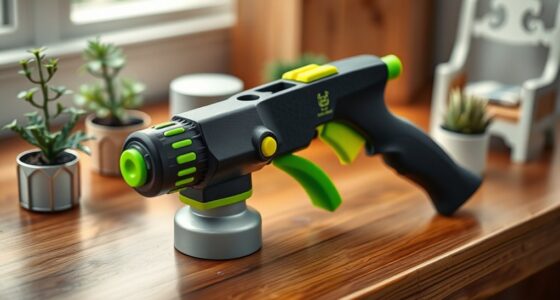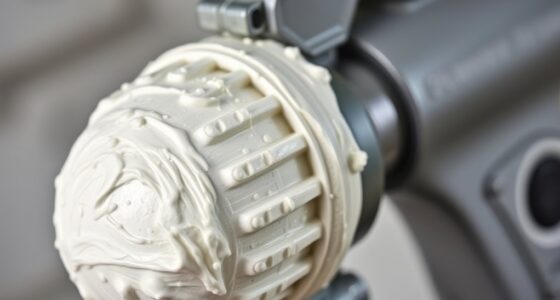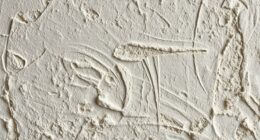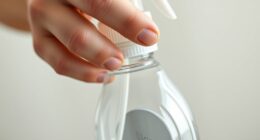If your project needs a smooth, professional finish with precise detail, a fine finish sprayer is the best choice. It offers better control, minimal overspray, and a flawless surface, perfect for furniture or cabinetry. On the other hand, if you want to cover large areas quickly and efficiently, a standard airless sprayer works better. To decide which suits you best and get tips on making the right choice, keep exploring further.
Key Takeaways
- Choose fine finish sprayers for high-quality, smooth surfaces on furniture, cabinetry, and detailed interior projects.
- Use standard airless sprayers for large areas like walls and exteriors requiring quick coverage.
- Fine finish sprayers offer better control and minimal overspray, ideal for delicate and precise work.
- Standard sprayers are more efficient for bulk applications but may produce less refined surface finishes.
- Consider project scope, desired surface quality, and speed when selecting between the two sprayer types.
Key Differences in Design and Functionality

When comparing fine finish and standard airless sprayers, their design and functionality reveal clear differences that impact performance. Fine finish sprayers prioritize sprayer ergonomics, offering a more comfortable grip and easier control, which helps you achieve smooth, precise results. They often feature adjustable spray patterns and more refined nozzles, allowing for detailed work. Noise levels also vary considerably; fine finish models tend to operate more quietly, making them ideal for indoor projects or areas requiring minimal disruption. In contrast, standard sprayers focus on higher output and speed, often with less emphasis on comfort or noise reduction. By understanding these design differences, you can choose a sprayer that aligns best with your project needs and working environment. Additionally, spraying techniques can further influence the quality and efficiency of your work, regardless of the sprayer type.
Suitability for Different Types of Projects

Choosing the right sprayer depends on your project’s needs. Fine finish sprayers excel at detail-oriented tasks and smaller projects, delivering smooth results. For large-scale applications, standard airless sprayers are more efficient and better suited to cover big areas quickly. Additionally, selecting the appropriate equipment involves understanding the investment flexibility and specific features of each sprayer type to ensure optimal performance.
Fine Finish Projects
Fine finish airless sprayers excel on projects that demand a smooth, flawless surface, such as cabinetry, furniture, or interior walls with high-end finishes. They provide superior paint adhesion, ensuring your finish looks professional and durable. These sprayers are ideal when you want minimal overspray and a clean application, which also reduces environmental impact by limiting waste and VOC emissions. If your project requires detailed work or a high-quality appearance, a fine finish sprayer gives you better control and a smoother coat. It’s perfect for upgrading your home’s interior or creating custom furniture pieces. While they may be slower for large areas, they deliver an impeccable finish that standard sprayers often can’t match. For projects where quality is a priority, fine finish sprayers are the best choice. Additionally, choosing the right type of sprayer can significantly impact color accuracy and overall finish quality, especially for projects requiring precise color control and consistency.
Large-Scale Applications
Large-scale applications often require equipment that can cover extensive areas efficiently and consistently. For such projects, standard airless sprayers excel, delivering higher flow rates and faster coverage. They promote better paint adhesion on large surfaces and reduce the environmental impact by minimizing overspray and waste. Imagine these options:
| Equipment Type | Ideal for |
|---|---|
| Fine Finish Sprayers | Precise, detailed large murals or decorative walls |
| Standard Sprayers | Broad, uniform coatings on commercial buildings |
Using the right sprayer ensures smooth, durable finishes while managing environmental concerns. For extensive projects, standard airless sprayers generally provide the speed, efficiency, and coverage you need, making them suitable for large-scale applications. Additionally, their ability to handle thicker paints and coatings without clogging makes them a versatile choice for various large-scale projects.
Detail-Oriented Tasks
When your project demands intricate detail and precision, standard airless sprayers may not be the best fit. Fine finish sprayers excel at providing superior painting precision, allowing you to achieve smooth, flawless surfaces on detailed woodworking, furniture, or decorative elements. They deliver a finer spray pattern, reducing overspray and guaranteeing you can work accurately in tight spots. Additionally, fine finish equipment is designed with durability in mind, handling delicate tasks without sacrificing performance. While standard sprayers may be more durable for heavy-duty applications, they often lack the finesse needed for detailed work. For projects requiring meticulous attention to detail, investing in a fine finish airless sprayer ensures you get the precision and quality your work demands. Proper spray pattern and spray technique are essential for achieving the best results with fine finish sprayers.
Speed and Efficiency Considerations
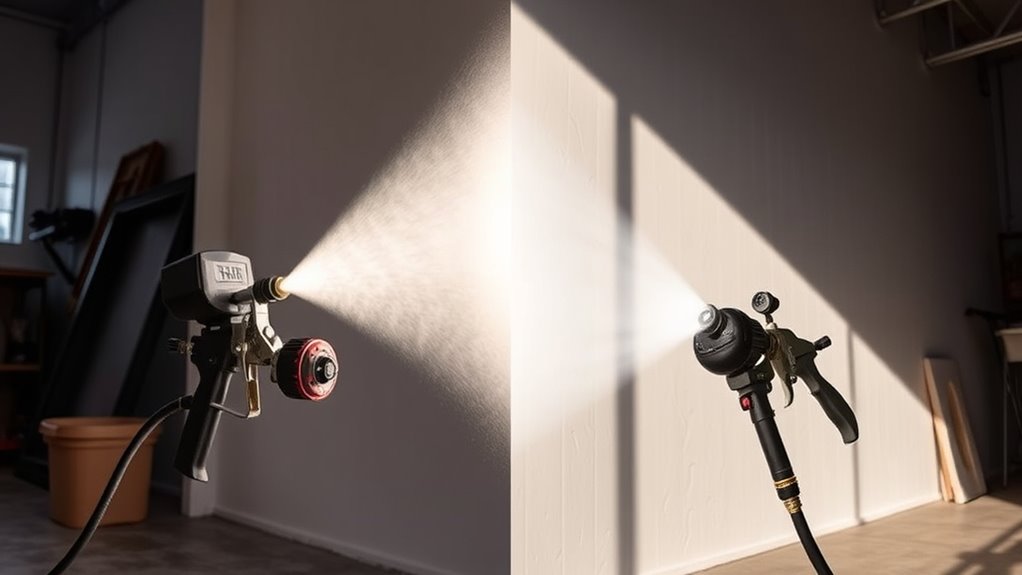
While both fine finish and standard airless sprayers can complete projects efficiently, their speed and productivity levels differ markedly. Fine finish sprayers prioritize precision, resulting in a slower paint speed and lower coverage rate. Standard sprayers, however, are designed for speed, covering large areas quickly with a higher coverage rate. This makes them ideal for bulk jobs but less suited for detailed work. Consider your project scope and desired finish when choosing. Use the table below to compare their efficiency: Additionally, selecting the appropriate tuning options can significantly enhance overall performance and efficiency in your projects.
Finish Quality and Surface Smoothness
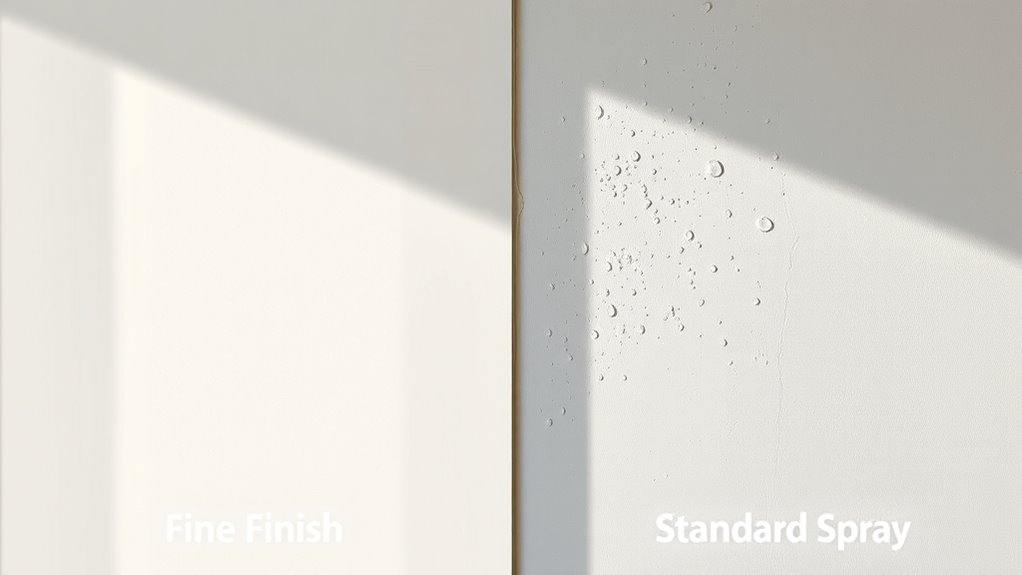
You’ll notice that spray pattern precision directly impacts the surface finish, giving you a smoother, more uniform look. Consistent surface quality depends on how well the sprayer maintains its pattern throughout the job. Choosing the right sprayer helps guarantee your final surface is flawless and professional.
Spray Pattern Precision
Spray pattern precision directly impacts the finish quality and surface smoothness of your project. When using a fine finish sprayer, you’ll notice a more consistent, controlled spray that adapts well to various paint viscosities. Better spray gun ergonomics allow you to maintain a steady hand, reducing overspray and uneven coverage. In contrast, standard sprayers may produce a wider, less precise pattern, which can lead to surface imperfections. The table below illustrates how different spray pattern qualities influence your results:
| Aspect | Fine Finish Sprayer | Standard Sprayer |
|---|---|---|
| Spray Pattern | Tight, uniform | Broader, inconsistent |
| Surface Smoothness | High, fewer imperfections | Lower, more surface flaws |
| Paint Viscosity | Handles varied viscosities | Less adaptable |
| Ergonomics | Designed for precision | Less ergonomic |
| Finish Quality | Superior, refined | Basic, less refined |
Additionally, understanding the atomization process helps in selecting the right sprayer for achieving a high-quality finish.
Surface Finish Consistency
Surface finish consistency hinges on the spray method you choose. With a fine finish sprayer, you’ll achieve a smoother surface with fewer imperfections, enhancing paint adhesion and creating a more uniform look. Standard airless sprayers may produce a less consistent surface, leading to uneven textures and potential issues with paint adhesion over time. The environmental impact also varies; fine finish sprayers often use less paint and overspray, reducing waste and airborne particles. This results in a cleaner work area and less environmental contamination. Additionally, material durability can be improved with the precise application of a fine finish sprayer. To guarantee top-quality finish and surface smoothness, selecting the right sprayer aligns with your goals for durability, appearance, and eco-friendliness. A precise spray method guarantees your project looks professional and lasts longer.
Ease of Use and Handling
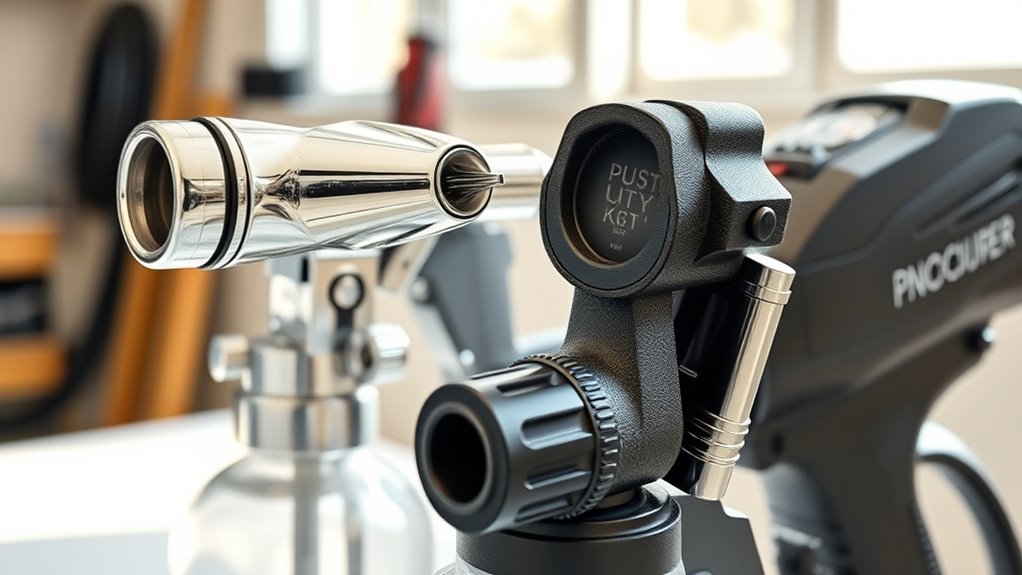
When comparing fine finish and standard airless sprayers, ease of use and handling play a crucial role in your decision. Fine finish sprayers typically prioritize ergonomics, with lightweight designs and comfortable grips that reduce fatigue during prolonged use. They are often more portable, making them easier to maneuver in tight or detailed areas. Standard sprayers may be bulkier and heavier, requiring more effort to control, but they often come with simpler controls that make operation straightforward. Your choice depends on how comfortable you feel holding and guiding the equipment. If you value precision and extended use without strain, fine finish sprayers offer superior handling. For quick, large-area jobs where portability is less critical, standard sprayers might suffice. Additionally, considering the ease of cleaning can significantly impact your overall experience with either type of sprayer.
Cost and Maintenance Factors

Cost and maintenance are important factors to contemplate when choosing between fine finish and standard airless sprayers. The cost comparison reveals that fine finish sprayers typically have higher initial prices but lower maintenance needs. Standard sprayers are less expensive upfront but may require more frequent repairs and parts replacement over time. To help you decide, here’s a quick overview:
| Aspect | Fine Finish Sprayers | Standard Sprayers |
|---|---|---|
| Initial Cost | Higher | Lower |
| Maintenance Requirements | Lower | Higher |
| Long-term Expenses | Lower | Potentially higher |
| Durability | Longer-lasting | Less durable |
Understanding these factors helps you balance upfront costs with ongoing maintenance needs, ensuring you choose the right sprayer for your project. Additionally, considering performance features can further influence your decision based on your specific application requirements.
Best Applications for Fine Finish Sprayers
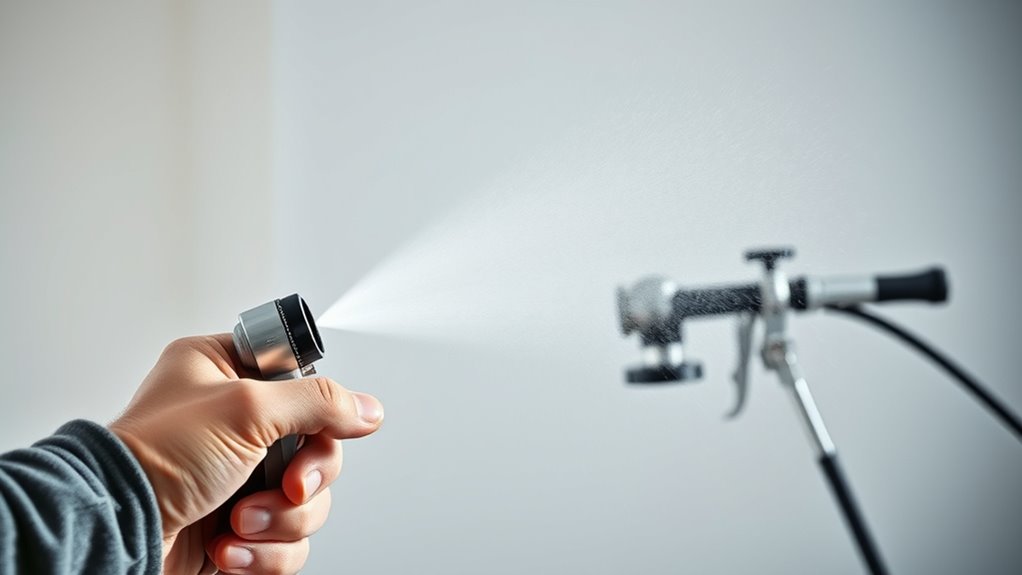
Fine finish sprayers excel in applications where achieving a smooth, high-quality surface is vital. They are ideal for detailed interior work, cabinet refinishing, and furniture painting, where a flawless finish matters most. To get ideal results, you need to focus on proper sprayer calibration, ensuring the spray pattern and flow are precise. Additionally, controlling paint viscosity is essential; too thick and it may clog the sprayer, too thin and it may run or drip. Fine finish sprayers are designed to handle lower pressure, providing a delicate spray that minimizes overspray and produces a sleek, polished look. Use them when your project demands a professional, smooth surface without visible brush marks or texture. Proper setup and attention to your paint’s consistency are key to success in these applications. For optimal operation, understanding air pressure and spray pattern adjustments can significantly improve your finishing quality.
When to Choose a Standard Airless Sprayer

Standard airless sprayers are your best choice when covering large surfaces quickly and efficiently. If you need a consistent paint texture across walls, ceilings, or exteriors, this sprayer type delivers fast, even coverage. They excel in projects where speed matters, such as painting a whole house or sizable commercial spaces. Additionally, equipment portability is a key factor—these sprayers are designed to be easily transported and set up, making them ideal for job sites with multiple locations. While they might not produce the ultra-fine finish of high-end sprayers, their ability to handle thicker paints and large volumes outweighs this limitation for many projects. Choosing the right paint sprayer can significantly impact your project’s efficiency and outcome. Choose a standard airless sprayer when efficiency, coverage, and portability are your top priorities.
Frequently Asked Questions
How Long Does It Take to Learn to Operate Each Sprayer Type?
You’ll find that the learning curve and training time vary depending on the sprayer type. Typically, it takes a few hours to a day to become comfortable operating a standard airless sprayer, especially if you’re familiar with similar tools. Fine finish sprayers may require a bit more training time—usually a day or two—since they demand more precision. Practice helps, so expect some initial adjustments before mastering each device.
Are There Environmental Benefits to Using Fine Finish Sprayers?
Imagine reducing your environmental impact while achieving a flawless finish. Fine finish sprayers offer eco-friendly benefits by minimizing overspray and waste, which leads to emission reduction. You’ll appreciate how they’re designed to operate efficiently, using less paint and energy. This environmentally conscious choice not only helps protect the planet but also promotes a cleaner, safer work environment. So, switching to fine finish sprayers supports your sustainability goals effortlessly.
Can Both Sprayer Types Handle Thick or Textured Paints?
Both sprayer types can handle thick paint, but standard airless sprayers are generally better for textured paint application because they can pump thicker coatings more easily. Fine finish sprayers might struggle with very thick or textured paints, often requiring thinning first. If you’re working with heavy or textured paints, opt for a standard airless sprayer to guarantee smooth, even coverage without clogging.
What Safety Precautions Are Necessary for Each Sprayer?
Imagine a spray mishap—dangerous, right? That’s why safety is vital. You must wear personal protective gear like masks, goggles, and gloves to shield yourself from overspray and fumes. Make sure proper ventilation to prevent inhaling harmful particles. Whether you’re using a fine finish or standard airless sprayer, following these precautions keeps you safe, minimizes accidents, and guarantees a smooth, worry-free painting experience.
Do They Require Different Storage Conditions?
You should consider their storage needs and temperature control. Fine finish and standard airless sprayers both require a clean, dry place, but fine finish sprayers often need more careful storage to prevent damage to delicate components. Keep them in a temperature-controlled environment to avoid freezing or overheating, which can affect performance. Proper storage guarantees longevity, reduces maintenance, and keeps your sprayers ready for use whenever you need them.
Conclusion
Choosing between fine finish and standard airless sprayers is like selecting a brush for a masterpiece—you need the right tool for the perfect result. If you aim for a flawless, smooth surface, a fine finish sprayer is your ideal ally. But for quick coverage on rough surfaces, the standard sprayer gets the job done. Remember, your choice shapes the final artwork—so pick wisely, and let your project shine like a well-crafted legend.



